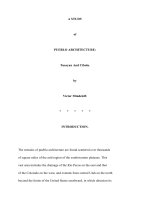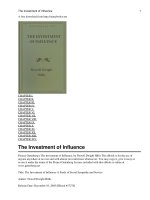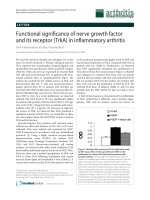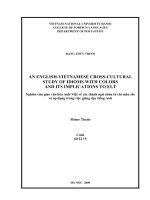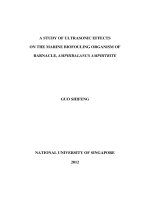A study of the immunomodulatory characteristics of FIP fve protein and its adjuvant effects in tumor immunotherapy
Bạn đang xem bản rút gọn của tài liệu. Xem và tải ngay bản đầy đủ của tài liệu tại đây (2.3 MB, 290 trang )
A STUDY OF THE IMMUNOMODULATORY
CHARACTERISTICS OF FIP-FVE PROTEIN AND
ITS ADJUVANT EFFECTS IN TUMOR
IMMUNOTHERAPY
DING YING
(M.D., Peking University Health Science Center, PRC)
A THESIS SUBMITTED FOR
THE DEGREE OF DOCTOR OF PHILOSOPHY
DEPARTMENT OF PAEDIATRICS
NATIONAL UNIVERSITY OF SINGAPORE
2009
i
ACKNOWLEDGEMENTS
First and foremost, I offer my sincerest gratitude to my supervisor, Professor
Kaw-Yan Chua, who has supported me throughout my PhD project with her patience
and knowledge, offering invaluable assistance and guidance.
Deepest gratitude also is offered to the members of the supervisory committee, Prof.
Mary Ng and Dr Yaw-Chyn Lim, without whose knowledge and assistance this
study would not have been successful.
I sincerely thank my senior, Dr See-Voon Seow, who has been providing continual
guidance and ideas in this project. I also thank my seniors, Dr Chiung-Hui Huang
and Dr I-Chun Kuo, for the exciting and stimulating discussions in science and for
some technical help. Special thanks are going to all my labmates, especially Miss
Lee-Mei Liew, Mdm Hui Xu and Mdm Hong-Mei Wen, for their technical
assistance.
I am very grateful to Dr Siew-Wee Chan for offering E7 cDNA as a gift, and Dr
TC-Wu for offering the TC-1 tumor cell line. I also convey thanks to the Faculty of
Medicine for providing the financial support and laboratory facilities.
Last but not least, I express my love and gratitude to my beloved families for their
understanding and endless love through the duration of my studies. To all my best
friends, I truly thank you for the sharing, joys, and company.
ii
TABLE OF CONTENTS
ACKNOWLEDGEMENTS i
TABLE OF CONTENTS ii
SUMMARY ix
LIST OF FIGURES AND TABLES xi
LIST OF PUBLICATIONS xiv
ABBREVIATIONS xv
Chapter 1 1
Literature review 1
1.1 Introduction 1
1.2 Tumor immunology 3
1.2.1 Historical Perspective of tumor immunosurveillance 3
1.2.2 Components of the Immmunosurveillance Network 6
1.2.2.1 IFN-γ in tumor immunosurveillance 6
1.2.2.2 Perforin in tumor immunosurveillance 9
1.2.2.3 Effector cells in tumor immunosurveillance 10
1.2.3 Tumor immunosurveillance in human 12
1.2.3.1 Tumor Recognition by lymphocytes in humans 13
1.2.3.2 Tumor-infiltrating lymphocytes correlates with patient
prognosis 15
1.2.3.3 Immunodeficient or immunosuppressed patients display
increased incidences of malignancies 16
1.2.4 Tumor immunoediting – refining tumor immunosurveillance 18
iii
1.2.4.1 Elimination 19
1.2.4.2 Equilibrium 20
1.2.4.3 Escape 21
1.3 Tumor immunotherapy 22
1.3.1 Tumor cell-based immunotherapy 24
1.3.2 Protein or peptide based immunotherapy 28
1.3.3 APC-based immunotherapy 30
1.3.4 DNA vaccine 35
1.3.5 Adoptive transfer of T cells 39
1.4 Adjuvants – strategies for optimizing vaccine for tumor
immunotherapy 43
1.4.1 Aluminum compounds 46
1.4.2 Mycobacterium bovis Bacillus Calmette-Guérin 48
1.4.3 Toll-like receptor ligands 50
1.4.3.1 Lipopolysaccharides and its derivate MPL 50
1.4.3.2 TLR 9 agonist-unmethylated CpG dinucleotides 52
1.4.4 Heat shock protein 55
1.4.5 Cytokines 59
1.4.5.1 IL-2 and its family members 59
1.4.5.2 IL-12 and its family members 61
1.4.5.3 GM-CSF 63
1.4.6 Costimulatory molecules 65
1.4.6.1 B7/CD28 Family 65
1.4.6.2 TNF/TNFR Family 67
1.5 The history and immunobiology of fungal immunomodulatory
proteins 70
1.6 Objectives and significance of the study 73
iv
Chapter 2 76
Materials and methods 76
2.1 Materials 76
2.1.1 Animals 76
2.1.2 Edible mushroom 77
2.1.3 Bacterial strains 77
2.1.4 Bacteria culture media 77
2.1.5 Cell lines 77
2.1.6 Cell culture media and supplements 78
2.1.7 Plasmids and reagents for gene cloning 79
2.1.8 Reagents for protein purification and identification 79
2.1.9 Antibodies and microbeads 80
2.1.10 Reagents for immunoassay 82
2.2 Methods 82
2.2.1 Preparation of native Fve protein, recombinant E7 protein, and
recombinant GST protein. 82
2.2.1.1 Purification of Fve protein from Flammulina velutipes 82
2.2.1.2 Construction of plasmid DNA pGEX-E7 83
2.2.1.3 Preparation of recombinant E7 protein 84
2.2.1.4 Preparation of recombinant GST protein 85
2.2.1.5 SDS-PAGE and immunoblot analysis 85
2.2.1.6 Determination of proteins concentration 86
2.2.1.7 Endotoxin removal 87
2.2.2 Preparation of immune cells 87
2.2.2.1 Preparation of single splenocyte suspension 87
2.2.2.2 Preparation of accessory cells/antigen presenting cells 88
2.2.2.3 Preparation of bone marrow-derived DCs 88
2.2.2.4 Preparation of splenic DCs 89
2.2.2.5 Lymphocytes purification using AutoMACS separator 89
2.2.3 Cell aggregation assay 90
v
2.2.4 Cell proliferation assay 90
2.2.5 In vitro cytokine production by Fve-stimulated T cells 91
2.2.6 Flow cytometry analysis 92
2.2.6.1 Cell surface marker staining and flow cytometry analysis
of the Fve-stimulated T subsets 92
2.2.6.2 Surface marker staining and flow cytometry analysis of
the Fve-stimulated dendritic cells 92
2.2.6.3 Surface marker staining and flow cytometry analysis of
the Fve-stimulated DCs with/without the help of T cells
93
2.2.7 Analysis of DC-directed CD4
+
and CD8
+
T cell activities 94
2.2.8 Cytokine analysis of Fve-stimulated NK cells in vitro 95
2.2.9 Immunization protocol in the E7 model experiments 95
2.2.10 Short-term T cell culture in vitro 95
2.2.11 Separation of dead cells from short-term cultured splenocytes
by Ficoll-Pague centrifugation 96
2.2.12 Intracytoplasmic cytokine staining 97
2.2.13 Stimulation of T cells by anti-CD3 and anti-CD28 mAbs 97
2.2.14 Immunoassay 98
2.2.14.1 Mouse cytokines ELISA 98
2.2.14.2 Mouse antibodies ELISA 98
2.2.15 Murine tumor model protocol 99
2.2.15.1 In vivo tumor protection assay 99
2.2.15.2 In vivo tumor therapeutic assay 99
2.2.15.3 In vivo tumor metastatic assay 100
2.2.15.4 In Vivo depletion of CD4
+
, CD8
+
T Cells and IFN-γ 100
2.2.15.5 T-cell adoptive transfer 101
2.2.16 Statistical analysis 101
vi
Chapter 3 103
Immunological characterization of Fve-stimulated immune cells 103
3.1 Introduction 103
3.2 Results 106
3.2.1. In vitro immunological characterization of Fve-stimulated
splenocytes and splenic T cells 106
3.2.1.1 Extraction and purification of Fve from cultivated
Flammulina velutipes
106
3.2.1.2 Dose-dependent proliferation of Fve-stimulated
splenocytes 106
3.2.1.3 The percentages of CD4
+
T cells and CD8
+
T cells in
Fve-stimulated splenocytes 107
3.2.1.4 Aggregations of purified CD4
+
T cells and CD8
+
T cells
in response to Fve 108
3.2.1.5 Up-regulation of CD69, OX-40 and 4-1BB expression on
Fve-stimulated T cells 108
3.2.1.6 Accessory cell-dependent T cell proliferation in response
to Fve stimulation 109
3.2.1.7 The cytokine profile of Fve-stimulated T cells 110
3.2.2 Phenotypic and functional analysis of Fve-stimulated DCs 112
3.2.2.1 Fve failed to up-regulate MHC class II, costimulatory
molecules on BM-DCs in vitro
112
3.2.2.2 Fve induced splenic dendritic cells phenotypic maturation
in vivo, licensed them for Th1 priming 113
3.2.2.3 Fve preferentially enhanced antigen-specific CD8
+
T cell
activation to produce high levels of IFN-γ and IL-2 114
3.2.2.4 Fve-activated T cells helped phenotypic maturation of
BM-DCs in a cell- cell contact dependent manner
115
3.2.3 Cytokine profile of Fve-stimulated NK cells 117
3.3 Discussion 145
vii
Chapter 4 157
Enhanced antitumor immunity by coadministration of HPV-16 E7
protein and Fve protein 157
4.1 Introduction 157
4.2 Results 160
4.2.1 Production of recombinant E7 protein 160
4.2.2 Co-administration of HPV-16 E7 plus Fve increased HPV-16
E7-specific humoral immune response
160
4.2.3 Coadministration of HPV-16 E7 and Fve enhanced IFN-γ
production by E7-specific CD4
+
and CD8
+
T cells 161
4.2.4 Coadministration of HPV-16 E7 and Fve enhanced protection of
mice against tumor growth 163
4.2.5 Therapeutic immunization of HPV-16 E7 and Fve suppressed the
tumor growth and prolonged the survival of tumor bearing mice 165
4.2.6 Both CD4
+
and CD8
+
T cell subsets and IFN-γ were essential
for the tumor protection 166
4.2.7 Adoptively transfer T cells from co-immunized mice retarded
the tumor growth 166
4.3 Discussion 186
Chapter 5 191
Conclusions and future perspectives 191
5.1 Conclusions 191
5.2 Future perspectives 194
5.2.1 Delineation of the proposed carbohydrate binding site of the
Fve protein 194
5.2.2 Identification of cellular receptor (s) involved in Fve interaction 195
5.2.3 Functional characterization of the Fve-induced OX-40 and
4-1BB expressing T cells.
196
5.2.4 Clarification of underlying mechanisms of Fve-activated T
viii
cell-dependent DC maturation. 196
5.2.5 Further functional studies on the Fve-induced splenic CD8
+
DC
subsets. 197
5.2.6 Exploration of the potential effects of Fve on NK cells. 198
5.2.7 Characterization of the possible interaction between Fve and
other immune cells. 198
5.2.8 Optimization strategies to enhance the adjuvant effects of Fve
for cancer immunotherapy. 199
5.2.9 Safety of Fve for human use. 199
Chapter 6 References 201
APPENDICES 250
Appendix 1: Fungal immunomodulatory protein (FIP) family. 250
Appendix 2: Wild type and cultivated form of Flammulina velutipes. 251
Appendix 3: Alignment of amino acid sequences of Fip-Fve, Fip-Gts,
Fip-LZ-8, and Fip-Vvo, immunomodulatory proteins. 252
Appendix 4: The overall three dimensional structure of Fve dimer solved by SAD
of a NaBr-soaked Fve crystal. 253
Appendix 5: Potential carbohydrate-binding sites of Fve. 254
Appendix 6: Structure and biological properties of mitogens. 255
Appendix 7: Schematic representation of the human papillomavirus 16
(HPV16) genome showing the arrangement of the major non-structural and
capsid genes.
256
Appendix 8: Publications 257
ix
SUMMARY
Fve is a 12.7 kDa fungal protein isolated from the Flammulina velutipes mushroom
and it has previously been reported to trigger immunological responses in both
mouse and human lymphocytes. In the present study, the immunomodulatory effects
of Fve on the T cells and dendritic cells (DCs) were investigated. In addition, the
potential application as an adjuvant for tumor immunotherapy was explored. In vitro
cell culture experiments showed that Fve stimulated full activation of both purified
CD4
+
and CD8
+
T cells to proliferate and secrete high levels of IL-2, IFN-γ, and
IL-6 accompanied by up-regulation of CD69, OX-40 and 4-1BB in the presence of
accessory cells such as DCs and B cells. Trans-well studies showed that accessory
cell-T cell direct interaction was important for T cell’s full activation. Moreover, in
vitro experiments showed that Fve failed to drive bone marrow-derived dendritic
cell’s (BM-DC) phenotypic maturation. In contrast, in vivo studies revealed that
intraveneously injected Fve could drive splenic DC phenotypic and functional
maturation as indicated by the up-regulation of MHC class II (MHC II) molecules
and CD86 expression on DCs and the DC’s capabilities of priming both the
antigen-specific Th1-skewed CD4
+
cells and CD8
+
T cells. Notably, it was found
that Fve-activated T cells could provide accessory help to induce phenotypic
maturation of DC in cell contact-dependent manner. Taken together, these data
demonstrated that Fve was capable of driving enhanced Th1-skewed polarization
and CD8
+
T cells activity in antigen-specific manner. In view of this, it was
hypothesized that Fve could act as a vaccine adjuvant to enhance the
x
immunogenicity of co-administered antigens. The proof of concept in vitro and in
vivo studies were carried out with HPV type 16 E7 protein as a model antigen in
tumor animal model induced by the cervical cancer related E7-expressing TC-1
tumor cells.
The results revealed that mice co-immunized with HPV-16 E7 and Fve showed
increased production of HPV-16 E7-specific antibodies as well as enhanced
expansion of HPV-16 E7-specific IFN-γ-producing CD4
+
and CD8
+
T cells as
compared to mice immunized with HPV-16 E7 alone. Tumor protection assays
showed that 60% as compared to 20% of mice co-immunized with HPV-16 E7 plus
Fve or immunized with HPV-16 E7 respectively remained tumor free for up to 167
days after the tumor cells challenge. Tumor therapeutic assays showed that HPV-16
E7 plus Fve treatments significantly prolonged the survival of tumor bearing mice as
compared to those treated by HPV-16 E7. In vivo cell depletion and adoptive T cell
transfer assays illustrated that CD4
+
, CD8
+
T cells and IFN-γ played critical roles in
conferring the anti-tumor effects. Therefore, I conclude that the pleiotropic
immunostimulatory effects of Fve on innate and adaptive immune cells leading to
enhanced polarization of antigen –specific CD4
+
and CD8
+
cells can be exploited to
develop effective adjuvant for anti-cancer and anti-viral vaccines.
(467 words)
xi
LIST OF FIGURES AND TABLES
Figure 2.1
Immunofluorescent staining of freshly isolated splenic
DCs for CD4 and CD8α
101
Figure 3.1
SDS-PAGE analysis of purified native Fve protein 117
Figure 3.2
Fve stimulated mouse splencyte proliferation 118
Figure 3.3
The aggregation of purified mouse CD4
+
T cells and
CD8
+
T cells after Fve stimulation
120-121
Figure 3.4
Fve stimulated CD69, OX-40, 4-1BB up-regulation on T
cells
122-123
Figure 3.5
Fve stimulated mouse spleen T cells proliferation in an
accessory cell-dependent manner
124
Figure 3.6
DCs can be accessory cells in the T cell proliferation
stimulated by Fve
125
Figure 3.7
B cells as accessory cells in the T cell proliferation
stimulated by Fve
126
Figure 3.8
Accessory cell-dependent proliferation of Fve-stimulated
T cell subsets
127
Figure 3.9
Profile of cytokine production by T cells stimulated with
Fve in vitro
128-130
Figure 3.10
Fve stimulated murine T cells to produce IFN-γ and IL-2
in different kinetics
131
Figure 3.11
Immunofluorecent staining of CD11c
+
DC after Fve and
LPS treatment
132
Figure 3.12
Fve induced splenic dendritic cells phenotypic maturation
in vivo
133
Figure 3.13
Fve-activated splenic DCs induced the antigen-specific
CD4
+
T cells priming
134-135
xii
Figure 3.14
Fve induced splenic dendritic cells phenotypic maturation
in vivo
136
Figure 3.15
Fve greatly enhanced antigen-specific responses of CD8
+
T cells
137-138
Figure 3.16
T cells helped phenotype maturation of BM-DCs
stimulated by Fve in a cell-to-cell contact manner
139
Figure 3.17
Preactivated T cells can help BM-DCs to up-regulate
MHC class II and CD86
140
Figure 3.18
Cytokine profile of NK cell stimulated by Fve in vitro 141
Figure 3.19
Three-dimensional structure of Fve and a proposed model
for the interactions between Fve and target cells
142
Figure 3.20
Proposed mechanisms by which Fve protein enhanced
innate and adaptive immune responses via cooperative
interactions between T cells, DCs and NK cells
143
Figure 4.1
The schematic diagram showing the strategy for HPV
related cancer immunotherapy using Fve as adjuvant
167
Figure 4.2
Analysis of recombinant E7 protein by SDS-PAGE and
western blot.
168
Figure 4.3
Fve enhanced E7-specific antibodies production in
C57BL/6 mice
169
Figure 4.4
Fve enhanced E7-specific antibodies production in
BALB/cJ mice
170
Figure 4.5
Cytokine profile by splenocytes from immunized
C57BL/6 mice
171
Figure 4.6
Cytokine profile by short-term cultured T lymphocytes
from immunized C57BL/6 mice
172
Figure 4.7
ICCS analysis by short-term cultured T lymphocytes
from immunized C57BL/6 mice
173
Figure 4.8
Co-immunization of E7 and Fve enhanced tumor 174-175
xiii
protection against the growth of TC-1 tumors
Figure 4.9
IFN-γ production by splenocytes in tumor-free mice of
day167 after tumor challenge
176
Figure 4.10
E7 plus Fve co-immunization extended the survival of
mice in metastatic prevention tumor model
177
Figure 4.11
E7 plus Fve co-immunization therapeutically reduced
tumor growth and extended the survival of tumor-bearing
mice
178-179
Figure 4.12
E7 plus Fve co-immunization extended the survival of
mice in metastatic therapeutic tumor model
180
Figure 4.13
CD4
+
, CD8
+
T cells and IFN-γ were essential for the
tumor protection in E7 plus Fve immunized mice
181-182
Figure 4.14
Adoptive transfer of T cells from the HPV-16 E7 plus
Fve immunized mice retarded the tumor growth
183
Figure 4.15
Proposed mechanisms by which Fve protein facilitates
innate and adaptive immune responses for tumor
immunotherapy
184
Table 3
The percentage of CD3
+
CD4
+
T cells and CD3
+
CD8
+
T
cells in total splenoctyte after stimulated by Fve in vitro
and the ratio of CD4/CD8 T cells
119
xiv
LIST OF PUBLICATIONS
Publication derived from the thesis:
1. Ding Y, Seow SV, Huang CH, Liew LM , Lim YC, Kuo IC, Chua KY.
Coadministration of the fungal immunomodulary protein FIP-Fve and a
tumour-associated antigen enhanced antitumour immunity. Immunology. 2009.
128(1 Suppl), e881-894.
2. Ding Y, Seow SV, Huang CH, Chua KY. The crosstalk of T cells and dendritic
cells in response to a fungal immunomodulatory protein FIP-Fve. (Manuscript in
preparation)
Publication in the related fields:
Liew LM, Huang CH, Seow SV, Ding Y, Wen HM, Kuo IC, Chua KY. Suppression
of allergen-specific Th2 immune responses by oral administration of recombinant
Lactobacilli strain in mice. (Manuscript in preparation)
xv
ABBREVIATIONS
ABTS 2,2’-Azinobis-(3-ethylbenzothiazoline-6-sulfonic acid)
ACs accessory cells
ACT Adoptive T cell immunotherapy
Ag Antigen
α-GalCer α-galactosylceramide
AIM activation inducer molecule
alum aluminum-based salt
AP ExtraAvidine Alkaline Phosphatase
APC Antigen Presenting Cell
BCG Bacillus Calmette-Guérin
Blimp-1 B lymphocyte maturation protein-1
bp Base Pair
BSA bovine serum albumin
CD Cluster of Differentiation
CD137L CD137 ligand
cDNA Complementary Deoxyribonucleic Acid
CFA complete Freund's adjuvant
CFA complete Freund's adjuvant
Con A Concanavalin A
cpm Counts Per Minute
CTL Cytotoxic T Lymphocytes
CWS cell-wall skeleton
DC dendritic cell
EA-1 early activation antigen
EDTA ethylenediamine tetraacetic acid
ELISA Enzyme-Linked Immunosorbent Assay
FBS fetal bovine serum
xvi
FCS fetal calf serum
Fips fungal immunomodulatory proteins
FNIII Fibronectin Type III
FPLC Fast Performance Liquid Chromatography
Fve Flammulina velutipes
G418 Geneticin
®
selective antibiotic
GM-CSF granulocyte macrophage colony-stimulating factor
GST Glutathione S-Transferase
GST glutathione S-transferase
HBSS Hanks balanced salt solution
hPBMCs human peripheral mononuclear cells
HPV Human papillomavirus
HSP Heat shock protein
IACUC Institutional Animal Care & Use Committee
ICAM-1 Intercellular Adhesion Molecule-1
IDO indoleamine 2,3 dioxygenase
IFN-γ Interferon-gamma
Ig Immunoglobulin
IgE Immunoglobulin Epsilon
IgG Immunoglobulin Gamma
IgSF Immunoglobulin Superfamily
IL-10 Interleukin-10
IL-12 Interleukin-12
IL-15 Interleukin-15
IL-2 Interleukin-2
IL-4 Interleukin-4
IL-6 Interleukin-6
IP-10 IFN-g-inducible 10-kDa protein
IP-10 IFN-g-inducible 10-kDa protein
xvii
IPTG isopropyl-β-D-thiogalactopyranoside
IRF-1 Interferon Regulatory Factor-1
kb Kilo Base Pairs
kDa Kilo Dalton
KS Kaposi’s sarcoma
LAL Limulus Amebocyte Lysate
LB Luria-Bertani
LPS Lipopolysaccharide
mAb monoclonal antibody
MAGE-1 melanoma antigen-1
MHC Major Histocompatibility Complex
MHC major histocompatibility complex
MICA/B MHC class I chain-related proteins A and B
min minutes
MIP-1 monocyte inflammatory protein-1
MIP-1 monocyte inflammatory protein-1
MMC Mammary carcinoma cells
MMC mammary carcinoma cells
neu-Tg neu-transgenic
NK Natural Killer
NUS National University of Singapore
ODNs Oligodeoxynucleotides
PAP prostate-specific acid phosphatase
PBMC Peripheral Blood Mononuclear Cells
PBS Phosphate Buffered Saline
PCR Polymerase Chain Reaction
PE Phycoerythrin
PEG Polyethylene Glycol
PerCP Peridinin Chlorophyll Protein
xviii
PHA phytohaemagglutinin
pNPP
ExtraAvidin-Peroxidase conjugate, para-nitrophenyl
phosphate
PSA prostate-specific antigen
RAG recombinase activating gene
RNA Ribonucleic Acid
RT-PCR Reverse Transcription-Polymerase Chain Reaction
scFv single-chain Fv fragments
SDS-PAGE
Sodium Dodecyl Sulfate-Polyacrylamide Gel
Electrophoresis
STAT signal transducer and activator of transcription
TAA tumor associated antigen
T-bet T-box Transcription Factor
Tc1 T Cytotoxic Type I
TCR T-cell receptor
TCR T cell receptor
Th1 T Helper Type I
Th2 T helper-2
TILs tumor infiltrating lymphocytes
TLR Toll-like receptor
TNF-α
Tumor Necrosis Factor-alpha
TNFR tumor necrosis factor receptor
Tregs regulatory T-cells
μg Microgram
μL Microliter
MFI mean fluorescence intensity
Chapter 1 Literature review
1
Chapter 1
Literature review
1.1 Introduction
The immune system can discriminate a range of stimuli, allowing some to provoke
immune responses, which lead to immunity, or preventing some from doing so,
which we call tolerance. In tumor immunology, tumor immunity or tumor tolerance
refers to the success or failure of the immune system against tumors, respectively.
The origin of tumor immunology dates to 1863, when Rudolf Virchow observed
leukocyte infiltration of tumors and for the first time suggested a possible
relationship between inflammatory infiltrates and malignant growth. In 1909, Paul
Ehrhich predicted that the immune system could repress the growth of carcinoma
1
.
However, the hypothesis could not be tested experimentally because of a lack of
quatititative in vitro techniques and the limited availability of molecular tools. Fifty
years later, Burnet and Thomas proposed a new concept: “immune surveillance.”
They believed that tumor cell-specific antigens could provoke an effective
immunologic reaction that would eliminate developing cancers
2,3
. Despite
subsequent challenges to this hypothesis over the next several decades
4-9
, cancer
immunosurveillance was validated in a series of studies
10-12
. These studies found
that antibodies and immune T lymphocytes can be detected in patients with
Chapter 1 Literature review
2
tumors
13-22
; tumors that have severe lymphocyte infiltration have a better prognosis
than those that do not
23-38
; immunodeficient patients have an increased incidence of
primary and secondary malignancies
39-47
; and tumor immunity can be demonstrated
in experimental animal models
48,49
.
However, spontaneous tumor eradication was rare. It originally was thought that
inefficiency of tumor-associated antigen (TAA) specific immunity is due only to
intrinsic cause: tumors do not represent enough tumor associated antigens; tumor
antigens have low immunogenecities; antigen-presenting-cells (APCs) do not have
sufficient stimulatory capacity; or there are not enough effective T cells or B cells.
Recent work recognized that pathological interactions between cancer cells and
host immune cells in the tumor environment can create an immune suppressive
network that promotes tumor growth, protect tumor from immune attack, and thus
attenuate immunotherapeutic efficacy
11,50,51
. In the tumor-associated antigen-based
immunotherapy, poor antigen-specific immunity is not due simply to the failure of
TAAs passively recognized by adaptive immunity. There is an active process of
“tolerization” taking place in the tumor microenvironment. These finding have led
to the development of the cancer immunoediting hypothesis, a refinement of
immunosurveillance that takes a broader view of immune system–tumor interaction
that compass both potential host-protecting and tumor-sculpting actions of the
immune systems throughout tumor development.
Therefore, successful tumor immunotherapy aims to enhance the TAA’s specific
Chapter 1 Literature review
3
immune response not only by boosting components of the immune system that
produce an effective immune response intrinsically but also by inhibiting
components that may induce tolerance. Besides, tumorogenesis is a slow process
that can occur over several years. Thus, how to generate an immune memory to
provide long-term protection against tumors also is a key point in tumor
immunotherapy.
In this chapter, I first provide evidences to support the existence of the tumor
immunosurveillance as it occurs in mice and humans and three phases of
immunoediting process, elimination, equilibriation, and escape. Secondly, I
summarize recent work on tumor immunotherapy, including vaccination and T cell
adoptive transfer. Thirdly, I review some adjuvants used in clinic trial, and finally, I
summarize the objective and significance of my thesis study.
1.2 Tumor immunology
1.2.1 Historical Perspective of tumor immunosurveillance
The validity of the tumor immunosurveillance hypothesis has emerged only
recently after proposed by Macfarlane Burnet and Lewis Thomas. In 1957, Burnet
stated
52
that small accumulations of tumor cells may develop and provoke an
effective immunological reaction with regression of the tumor. Almost at the same
time, Thomas suggested that the primary function of cellular immunity was, in fact,
to protect from neoplastic disease and maintain tissue homeostasis in a complex
Chapter 1 Literature review
4
multicellular organism
2
. Later on, several groups of investigators demonstrated: a)
that the immune system of inbred mice and rats can recognize antigens expressed
by tumor cells induced by chemical carcinogens; b) that such recognition results in
rejection of a subsequent challenge of the same tumor in previously immunized
animals; and c) that immune cells but not antibodies can mediate this reaction
53-55
.
Based on these findings, Burnet defined the concept of tumor immunosurveillance
in 1970 as follows
3
. In large, long-lived animals, like most of the warm-blooded
vertebrates, inheritable genetic changes must be common in somatic cells and a
proportion of these changes will present a step toward malignancy. It is an
evolutionary necessity that there should be some mechanisms for eliminating or
inactivating such potentially mutant cells and it is postulated that one of the
mechanisms is of immunological character.
The proposal of the immunosurveillance hypothesis quickly was challenged by
subsequent experimental tests using athymic nude mice
4,9
. They found that CBA/H
strain nude mice did not form more spontaneous or chemically induced tumors, nor
did they show a shortened tumor latency period compared with wild type
control
5-8,56
. For example, in an experiment by Stutman, nude mice or control were
injected subcutaneously with 0.1 mg of the chemical carcinogen MCA at birth and
were monitored for tumor incidence
7
. After 120 days, five of 27 nude mice formed
tumors at the injection site with a mean time to tumor appearance of 90 days. Of
the control mice tested, seven of 39 formed tumors with a mean time to tumor
appearance of 95 days. There wase no significant difference between nude mice
Chapter 1 Literature review
5
and their counterpart control when using different doses of carcinogen or mice with
different age
8
. Moreover, these observations were supported by studies of Rygaard
that showed no differences in spontaneous tumor formation in 10,800 nude mice
over a study period of three to seven months
5,6
. Due to the limited understanding of
immunologic defects in the nude mice at that time, these results were highly
convincing and thus resulted in the abandonment of the immunosurveillence
hypothesis.
We know now that there are several important caveats to these experiments that
could not have been appreciated at the time. Firstly, nude mice have natural killer
(NK) cells that may provide some tumor immunosurveillance capacity
57
. Secondly,
the nude mouse now is recognized to be an imperfect model of immunodeficiency.
These mice produce low but detectable numbers of functional populations of αβ T
cells and therefore can manifest at least some degree of protective immunity
58,59
.
Thirdly, the CBA/H strain mice used in Stutman’s MCA carcinogenesis
experiments express the highly active isoform of the aryl hydroxylase enzyme that
is required to metabolize MCA into its carcinogenic form
60,61
. Therefore, it is
conceivable that MCA-induced cellular transformation in CBA/H strain mice
occurred so efficiently that it masked any protective effect that immunity could
provide. Nevertheless, the Stutman experiments were considered to be so
convincing at that time.
From the 1990s, several key findings invigorated interest in the process of tumor
Chapter 1 Literature review
6
immunosurveillence with the development of technologic advances in mouse
genetics and monoclonal antibody (mAb) production. Firstly, endogenously
produced IFN-γ was shown to protect the host against the growth of transplanted
tumors and the formation of primary chemically induced and spontaneous
tumors
48,62-67
Secondly, mice lacking perforin (pfp
-/-
) were found to be more
susceptible to MCA-induced and spontaneous tumor formation compared with their
wild type
64,65,68-71
. Thirdly, gene-targeted mice that lack the recombinase activating
gene (RAG)-2 definitely validated that lymphocytes play a key role in the tumor
immunosurveillance
48,72
. Moreover, there was evidence showing that the IFN-γ and
lymphocyte-dependent extrinsic tumor suppressor mechanisms were heavily
overlapping
48
.
These data, therefore, showed that components of the immune system were
involved in controlling primary tumor development and overwhelmingly support
the existence of an effective cancer-immunosurveillance process in mice.
1.2.2 Components of the Immmunosurveillance Network
1.2.2.1 IFN-γ in tumor immunosurveillance
IFN-γ originally was recognized for its capacity to protect naive cells against
microorganism infection, but now it is known to have a critical role in protecting
the host from the development of neoplasia and thus has been regarded as an
obligate component in tumor immunosurveillance. In one work from Dighe,

